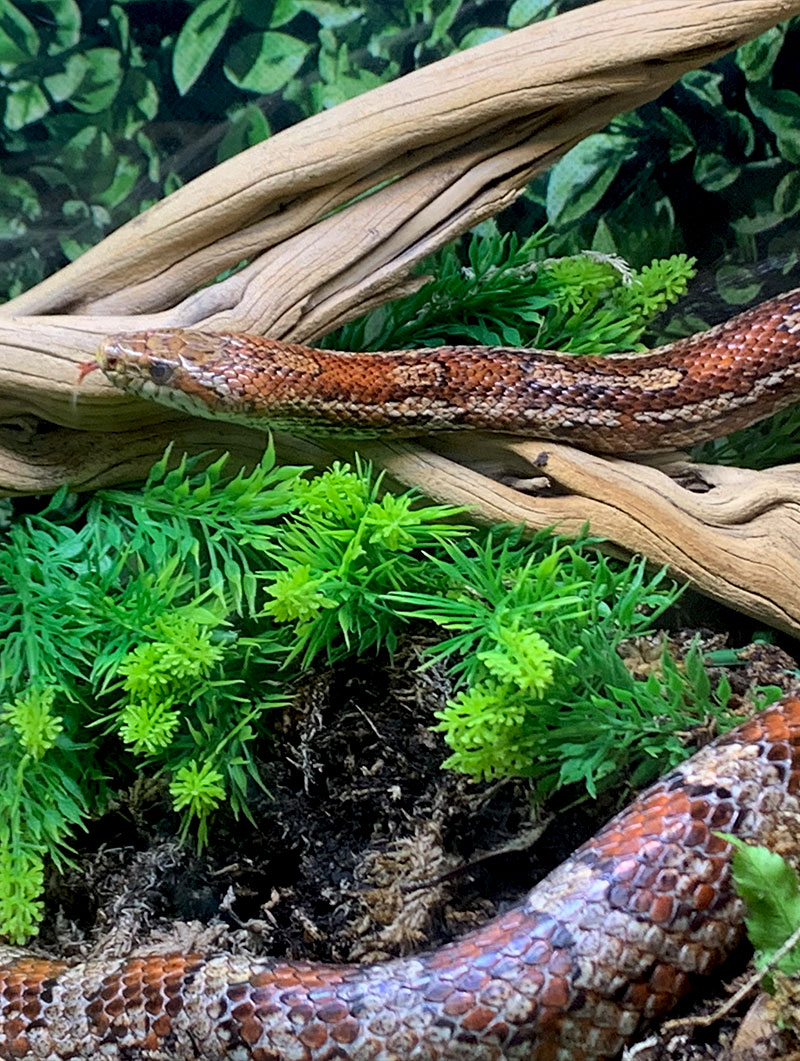Corn Snake
Pantherophis guttatus
Description:
Corn snakes are slender snakes that range in color from orange to brownish-yellow. Their backs are patterned with reddish blotches loosely outlined in black. Their belly scales resemble a checkerboard with rows of alternating black and white marks. Pattern and color vary greatly among individuals and can be dependent on age and geographic location.
Size:
Corn snakes are approximately 24 to 72 inches (61 to 182 centimeters) long. They weigh 1 to 3 pounds (454 to 1361 grams).
Adaptations:
- When threatened, a corn snake may rattle its tail in dry leaves to mimic the sound and appearance of a rattlesnake.
- The coloration of the dorsal (back) scales allows corn snakes to camouflage amongst the leaf litter, allowing them to sneak up on prey or hide from predators.
Diet:
Corn snakes are constrictors, coiling their bodies around prey to suffocate it before consumption. They feed on a variety of small animal species such as rodents, lizards, frogs, birds, and bats. The corn snake at Cosley Zoo is fed mice.
Reproduction:
Breeding season occurs from March to May. A clutch of 10 to 25 eggs is typically laid between late May and July in locations ideal for incubation such as rotting stumps or piles of decaying vegetation. The eggs incubate for 60 to 65 days and hatch between July and September. Hatchlings lack the bright coloration seen in adults and are duller in color.
Shelter and space needs:
Corn snakes are found in the eastern United States from southern New Jersey to Florida, into Louisiana and parts of Kentucky. They can be found as far west as Illinois. Introduced populations have also been established in New Providence and Grand Bahama (Bahamas), Grand Cayman, St. Thomas (U.S. Virgin Islands), and the Lesser Antilles. This species is very adaptable and therefore lives in a wide variety of habitats including wooded areas, rocky hillsides, tropical groves, barns, and abandoned buildings. Corn snakes will readily climb trees and enter abandoned buildings in search of prey; however, they are secretive and spend most of their time hiding under loose bark, beneath logs, rocks, and other debris, or slithering through rodent burrows looking for their next meal.
Life expectancy:
Corn snakes live into their 20s in human care. Their lifespan is shorter in the wild averaging around 6 to 8 years.
Relationship with man:
Corn snakes play an important role in their ecosystems by helping control pest populations and reducing the spread of diseases associated with the rodent populations they consume. While the corn snake population appears stable overall, it is listed as a species of special concern in Florida and is protected in Georgia due to habitat loss. The primary threat to corn snakes across their range is fear-based killing; their coloration causes people to mistake them for the venomous copperhead. In the past, this species was often collected from the wild for the pet trade. Today, captive breeding programs have helped resolve this problem, and corn snakes are now the most bred snake species in the pet industry.
Fun Facts:
- There are two possible origins for the name “corn” snake. The first is that the checkered belly markings are similar in appearance to the kernels of maize, or Indian corn. The second suggests they got their name from commonly being found in corn cribs feeding on rodents.
- Corn snakes are also commonly called “red rat snakes.”






